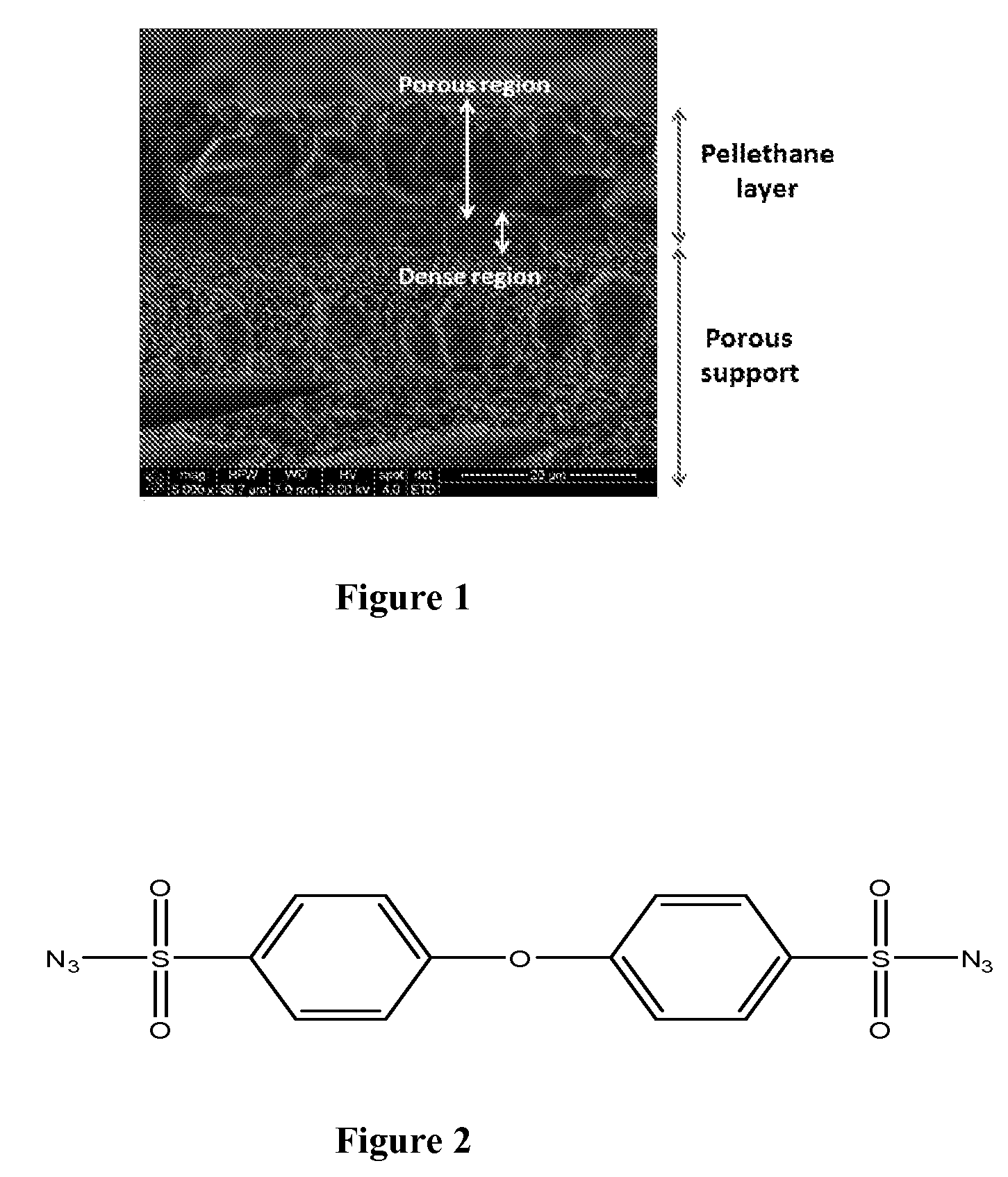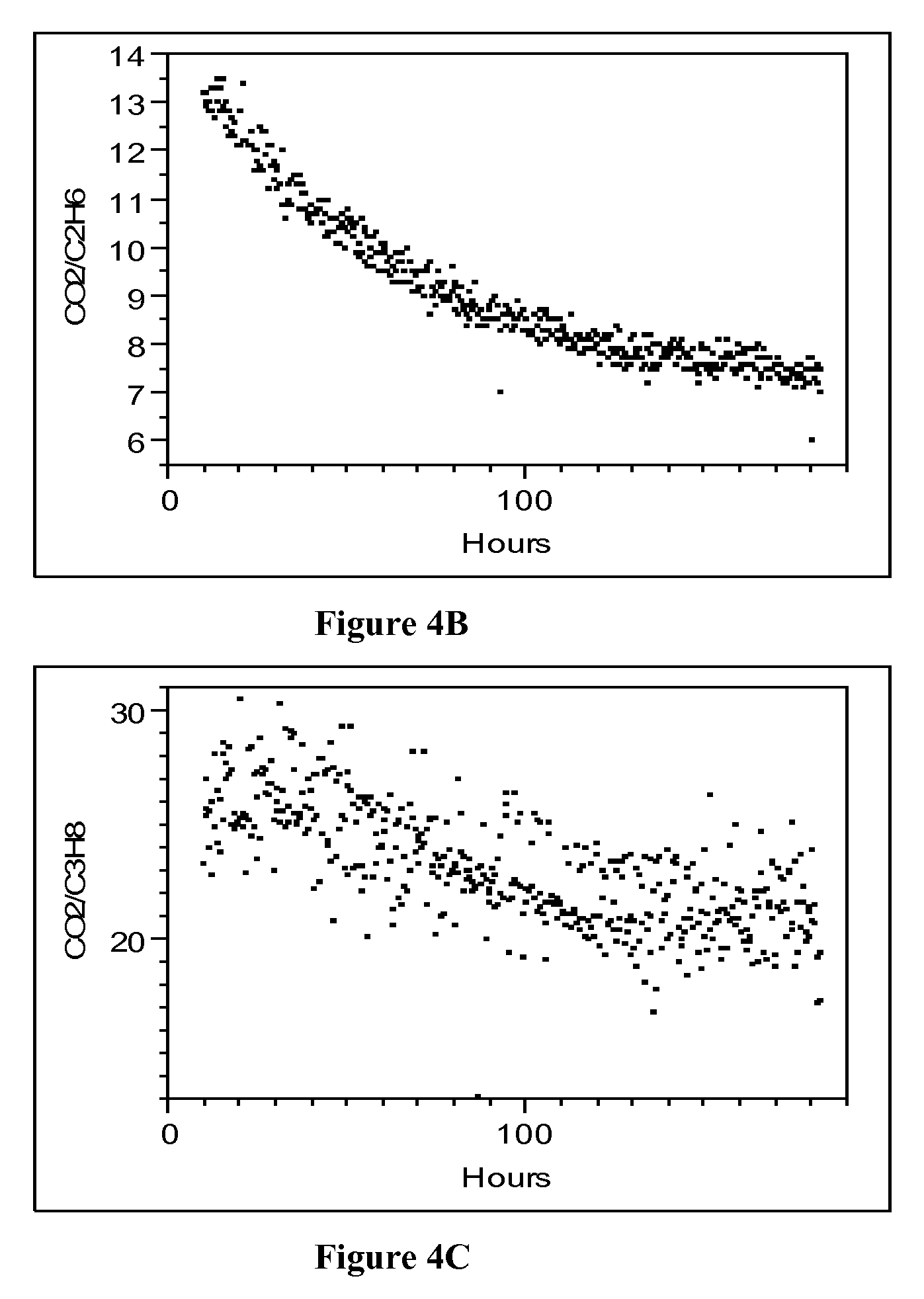Radiation cured membranes derived from polymers that are co-reactive with azide crosslinking agent(s)
a crosslinking agent and azide technology, applied in the field of membrane separation technology, can solve the problems of high temperature dependence of permeability and selectivity, obstacles to use of a particular polymer, permeation rate, etc., and achieve high selectivity, promote high acid gas flux characteristics, and promote high permeability
- Summary
- Abstract
- Description
- Claims
- Application Information
AI Technical Summary
Benefits of technology
Problems solved by technology
Method used
Image
Examples
example 1
Making C2C50% Polymer Useful as a Membrane Compound in the Practice of the Present Invention
[0128]Step (a) Preparation of the diamide diol, ethylene-N,N′-dihydroxyhexanamide (C2C) monomer:
[0129]A diamide diol monomer (referred to as the C2C diamide diol monomer or the C2C monomer) is prepared by reacting 1.2 kg ethylene diamine (EDA) with 4.56 kilograms (kg) of ε-caprolactone under a nitrogen blanket in a stainless steel reactor equipped with an agitator and a cooling water jacket. An exothermic condensation reaction between the ε-caprolactone and the EDA occurs which causes the temperature to rise gradually to 80 degrees Celsius (° C.). A white deposit forms and the reactor contents solidify, at which the stirring is stopped. The reactor contents are then cooled to 20° C. and are then allowed to rest for 15 hours. The reactor contents are then heated to 140° C. at which temperature the solidified reactor contents melt. The liquid product is then discharged from the reactor into a c...
example 2
Using Azide Crosslinking Agent and C2C50% Polymer to Make a Membrane
[0136]5 g of C2C50% polymer and 0.6 g of bisazide A were dissolved in 20 mL of chloroform. Once dissolved, solution was cast onto 100 mm Teflon petri dish and covered to allow solvent to evaporate. After casting and drying, sample was placed in an oven at 130° C. and allowed to cure for 72 hours. Sample was then removed and allowed to cool to room temperature.
example 3
Preparation of PEA Polymer Containing 18 Mole Percent of C2C Monomer (Polymer Herein Referred to as C2C18% Polymer)
[0137]Into a 1-neck 500 mL round bottom flask is loaded titanium (IV) butoxide (0.31 g, 0.91 mmol), N,N′-1,2-ethanediyl-bis[6-hydroxyhexanamide] (C2C monomer, 30.80 g, 0.1068 mol), dimethyl adipate (103.37 g, 0.5934 mol), and 1,4-butanediol (97.33 g, 1.080 mol). A stir-shaft and blade are inserted into the flask along with a modified Claisen adaptor with Vigreux column and distillation head. Apparatus is completed with stir bearing, stir motor, thermometer, take-off adaptor, receiver, heat-tracing and insulation, vacuum pump, vacuum regulator, nitrogen feed, and temperature controlled bath. Apparatus is degassed and held under positive nitrogen. Flask is immersed into a 160° C. bath with temperature raised to 175° C. for a total of 2 hours. Receiver is changed and vacuum is applied according to the following schedule: 5 minutes, 450 Torr (60 kiloPascals (kPa)); 5 minute...
PUM
| Property | Measurement | Unit |
|---|---|---|
| temperature | aaaaa | aaaaa |
| thickness | aaaaa | aaaaa |
| thermal transition temperature | aaaaa | aaaaa |
Abstract
Description
Claims
Application Information
 Login to view more
Login to view more - R&D Engineer
- R&D Manager
- IP Professional
- Industry Leading Data Capabilities
- Powerful AI technology
- Patent DNA Extraction
Browse by: Latest US Patents, China's latest patents, Technical Efficacy Thesaurus, Application Domain, Technology Topic.
© 2024 PatSnap. All rights reserved.Legal|Privacy policy|Modern Slavery Act Transparency Statement|Sitemap



